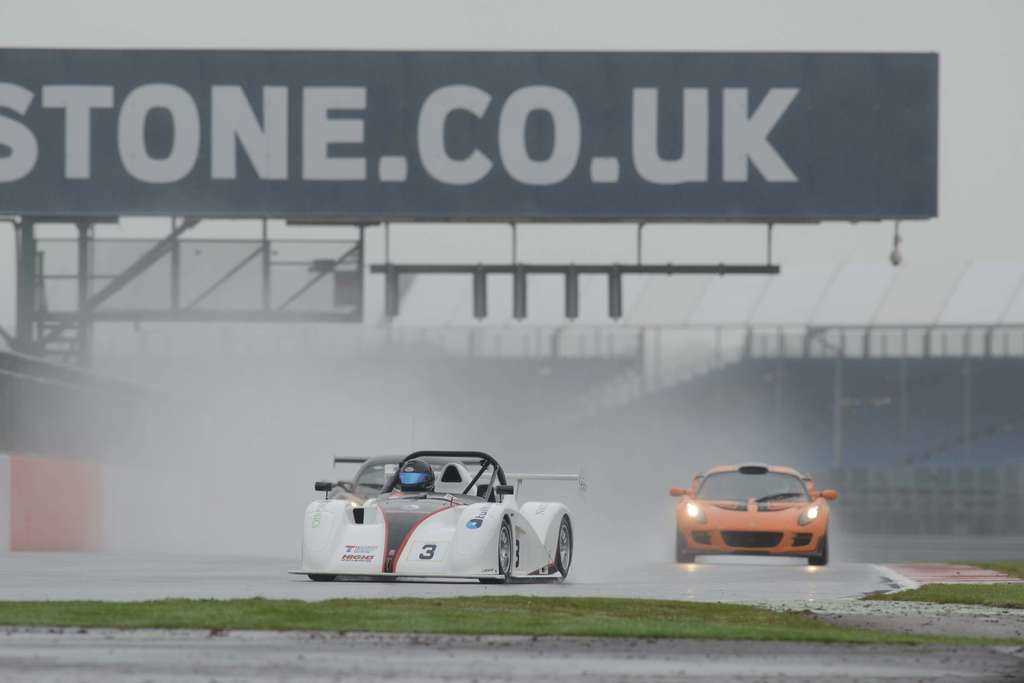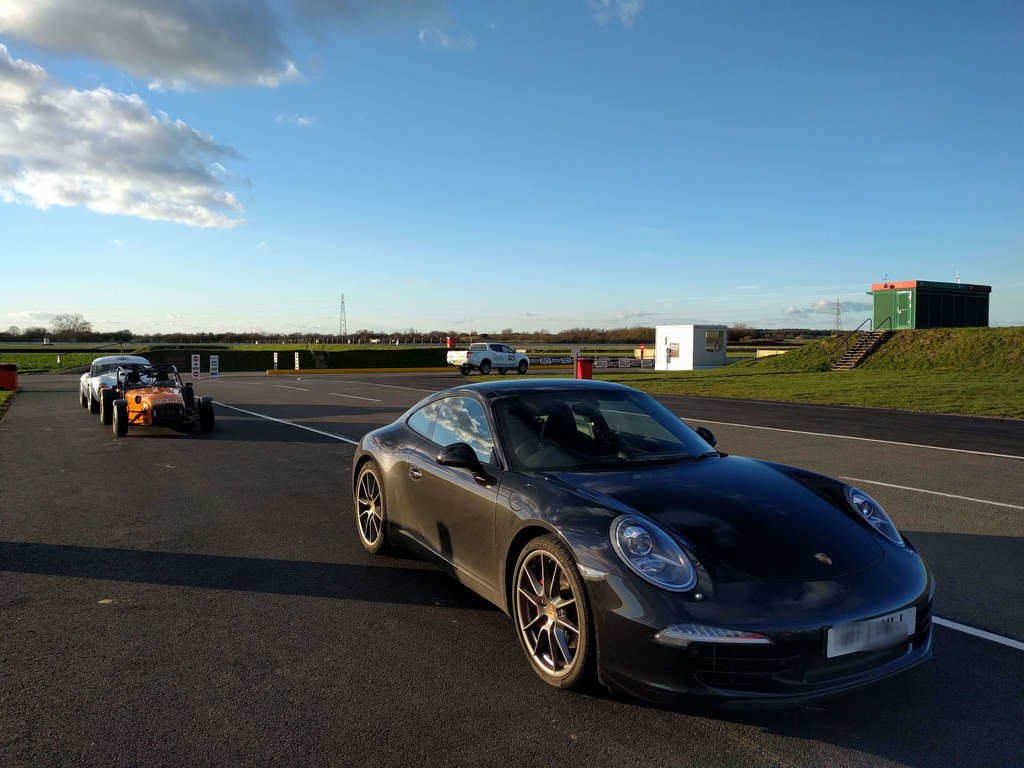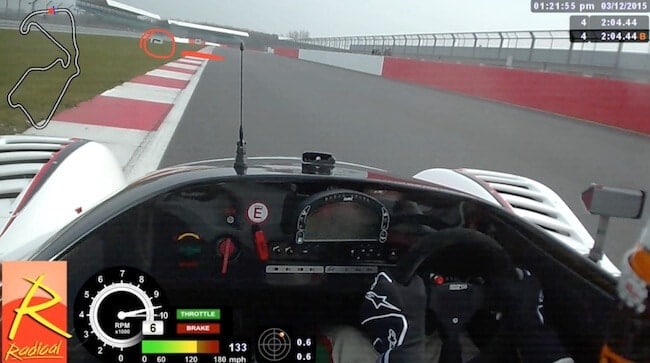NEW: We’ve launched a driver handling and car control course. For more information, take a look at the course page here.
“You really need to work on your car handling, mate”
That was the advice from James Littlejohn, Historic F1 driver, Radical European Masters Champion, all round top guy and one of our recommended racing driver coaches.
Of course, he was quite right.
Around that time, I was driving around on track with next to no confidence. I didn’t know what the car was going to do. It was no fun. Here I was, completely committed to achieving a lifelong dream of racing sportscars and I was scared of the thing.

A pretty frightening day at a very wet Silverstone surrounded by road cars and a BMW X5! Low confidence levels, cold and wet meant for a pretty disappointing day
It’s a horrible feeling: not knowing why you’re not quick, feeling under an awful lot of pressure to be quick but genuinely in the dark as to what you’re feeling in the car.
Under confidence turns into dread and the guys that are quick per lap seem like magicians. Worse, they seem really brave.
Bravery has absolutely nothing to do with it. In fact “bravery” alone breeds over confidence. Over confidence is probably just as bad as under confidence; if not worse. It’s certainly more expensive. What you really need is a bit of education and thought.
By the end of a good few days of car handling training, everything changed. I’ve found my first ever proper bit of car handling, some drifting at Brands Hatch, it’s rough but this felt like a monumental break through in this car:
Exchange Bravery for Education
The antidote to a bit of under confidence isn’t a measure of Dutch courage; it’s this. Learning and practicing car handling and making it your top priority.
Once you’ve got a sense for the movement of the car, and you learn to control it, reconciling the feedback you get through your seat with what’s actually happening, a whole new world opens up for you.
It’s literally a revelation, and I think my few days working on car control set me up for rapid progression on the circuit. Absolutely no bravery required. Just careful thought, self analysis and the right help to get you there.
If you’ve got time, I recommend watching a few video interviews with driver coach Rob Wilson. In this video, “Why Vettel is so fast” Rob highlights how fine manipulation of the car can give you earlier, better rotation in slow corners. That skill, combined with excellent vision, is why Vettel is such a good racing driver. Slow corners is exactly where you should start your car handling career!
I also recommend spending some time getting to grips with the fundamentals of weight transfer. You need to understand how you’re moving the mass of the car around as you steer, brake and accelerate. This University video will give you everything you need.
Learning Car Handling – The Plan
So here’s (in my humble opinion) how I think a perfect car handling course should go. I’ve written these points based on what I experienced earlier this year, though I’ve included some areas that I wish I’d spent more time on, in particular high speed corner work.

Car handling 101, day 1. A great first day at Blyton Park
Day 1: in a Road Car
Blyton Park’s such a good little circuit. It’s well off the beaten path and in the Winter, you might not have many more than 2 other cars on the track all day. The circuit has a fantastic mix of slow and medium speed corners and with plenty in the run off department, it’s ideal for learning.
When you’re under instruction in a road car, everything’s so easy. Air conditioning (or heating!) on, with a quiet cockpit so you can receive detailed feedback in real time. Weight transfer is nice and slow and there are plenty of driver aids to cover up your rookie mistakes.
We spent most of the day driving round the circuit focusing in two key areas:
- Vision
- Manipulating the car on corner entry
Vision
First of all, vision is everything. As I said in my previous post, if you’re not looking where you want to go, you’re going to really struggle in the car.
![]()
Take a look at this video using eye tracking in an F1 car with Nico Hulkenberg.
Your vision transforms your confidence in the corners, but it’s not an intuitive procedure at the beginning. It’s really important to identify the apex of the corner before you’re braking. As you’re approaching the apex, your eyes should be focused on the exit.
This technique gives you a nice, smooth corner entry and exit technique.
It’s amazing how getting your sighting right makes manipulating the car into the corner really easy. I know that doesn’t sound likely but this is exactly what started to happen in the road car. Getting your vision right at the track gives you the correct line, and in turn makes the manipulation of the car easier.
For more on vision, take a look at Scott’s video on the subject in the Driver’s Uni.
Weight transfer: Manipulating the Car in the Corner
As you enter the corner you trail off the brakes with a nice, smooth action (try to get it so smooth that the passenger can’t feel you coming off the brakes). As you trail off the brakes you gently steer the car into the apex. That’s when the rotation happens!
At first the feeling is odd; counter intuitive and something you may never have experienced before. But with practice it becomes extremely fun!
As I got confident with the Porsche, I started playing around with it a bit. I think that’s an instinctive response as confidence grows and the sign of a very successful first day.
Day 2 in Your Track Car (Low / Medium Speed Corners)
Day 2 started back at the same circuit. Learning a circuit takes time as a novice, it’s important to start where you left off.
Only this time, it’s in the significantly quicker and less forgiving Radical SR1.
The process on day 2 is to find the right corner entry pace to get the car rotating, just like the road car.
What you’ll find in the transition to a racing car is that everything happens faster. That’s fine, just build up the pace slowly, increasing very gradually on each lap. Eventually you’ll find the limit of grip. At that point you realise the technique for driving both the road car and track car is exactly the same.
The only caveat to jumping in a racer like a Radical SR1 is there’s no traction control or ABS. This means that you have to be very smooth on the brakes and aware of any potential locking. A good way to do this is to find a safe part of the the track to induce a small lock. Then you’ll know, instinctively, where the grip levels under braking are in those conditions.
You also have to watch the throttle on corner exit. Most road cars have a very forgiving traction control system, so you can be quite careless on the throttle in the exit of a corner. This is not the case with a car that has no driver aids. As your confidence grows, you’ll find yourself balancing the car with the throttle in the exit of the corner.
Getting a clean exit with maximum traction is a real art, something Scott talks about in this Driver’s University video.
The end result, not bad for day 2 with some nicely managed rotation in the slower corners. You could see that I wasn’t massively confident on the throttle in some exits though.
By the end of day 2 try to be as confident in the slow and medium corners as you were in the road car. Getting that movement happening underneath you on entry, mid corner and exit and try to build your confidence as you progress through the day.
Day 3 (High Speed Corner Technique)
Blyton Park is amazing for car control but it doesn’t have any really high speed corners. Think: Riches at Snetterton, Old Hall at Oulton Park, Copse at Silverstone.

Copse Corner at Silverstone taken from the Silverstone GP Circuit Guide
Looking back I wish I’d had chance to do more high speed corner work. The technique for a fast high speed corner entry depends much more on achieving a nice even balance in the car. My mistake was braking too hard, which leaves the car balance on the front tyres, which makes the car feel like it won’t get round the corner.
Over slowing the car, realising you’re too slow and getting on the throttle a long way before the apex is the tell tale sign you’ve got the corner wrong.
The right approach (and what I really wished I’d spent more time practicing at a circuit like Silverstone National) is to brake less! Get off the brakes, balance the car into the apex and then get on the throttle for the exit.
You instinctively feel like you have more grip with this approach, which means you have plenty of scope to start finding the limit of grip into the corner.
Day 4 Drifting
We’re at the final day! Drifting a car around won’t teach you the finer points of fast track driving technique but it gives you something so important. Confidence.
Once I’d gathered a bit more experience, I took to the car park at Silverstone with Andrew Bentley to have a bit of a hoon around. Drifting a car is heaps of fun.
If you go out and do some drifting, try to organise your own car and go out with an instructor on your own. You get a lot more seat time and the course adapts to your particular needs. In my case, a bit of drifting followed by some cornering work really helped.
I didn’t take much footage but here’s an example of a layout we used that I don’t think we’d have had an opportunity to try with a large group of people.
And that’s pretty much how I learned car handling, with a few tweaks thrown in if I could do the course again. Don’t repeat my mistakes; car handling is the most important skill to develop to really enjoy your days on track.
If you’re interested to learn more, I recommend a few more handy videos in the university:
About the author
Richard Baxter is an amateur driver having run in Radicals, Funcup cars, Mazda MX5’s and Classic Formula Ford
Read his personal blog, Purplemonkeydishwasher here, Follow him on Twitter here or follow his sim racing action at simracingcockpit.com.
